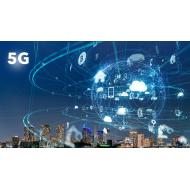5G, the fifth generation of wireless communication technologies, is now a reality after years of rumours and expectations. Its predecessor 4G, also commonly known as LTE (Long Term Evolution) technology, has to date represented one of the biggest deployments as regards communication networks. This is one of the reasons to try to once again make the maximum use of this infrastructure, with the aim of optimising future roll-outs of 5G and subsequent technologies.
Before enumerating the fundamental differences between both technologies, it is first necessary to analyse the background to the wireless mobile telephony networks. In the past decade, the aim of these networks has gone from being the initial starting point designed to provide coverage for the mobile telephone service to an Internet access network. This access has gone adjusting to the demand of the user, who today consumes huge daily quantities of multimedia content. In order to adapt to this demand, the mobile telephone networks have been jumping between different generations (from 2G to 5G) in record time, if we compare this evolution with any other, regardless of the sector being analysed.
Telecommunication companies seek to offer the user the greatest capacity for downloading and exchanging data, with the aim of covering these increasingly more aggressive Internet consumption needs. As a result, 5G has been constructed on the premise of a fundamental technological challenge: increasing the data transmission speed.
From a technical-theoretical point of view, thanks to advances in signal processing, and wireless communication techniques, data transfer rates are being achieved that are up to 100 times higher than that of a fourth generation technology. Put it this way, this does not sound particularly amazing. However, for the user, the fact that the download of a film via their favourite platform will take just one minute, when before it used to take more than an hour, changes the way we see a technology that is starting to reach unimaginable limits.
Similarly, another of the technological challenges of the wireless networks lies in what is known as latency. In other words, we no longer talk about download speed, but rather the time it takes the request made from a device to travel through the network to the recipient.
The fifth generation seeks to reduce these times which, in the best case scenario using 4G technology, vary between 20 and 100 milliseconds, to times of less than 1 millisecond. This has become a determining factor in the light of emerging technologies such as remote medical operations or the driverless car. In these cases, the journey made by the information has to be almost immediate in order to simulate human reaction times.
One of the most interesting properties offered by the technology and the fields of scientific research is the ability to provide everyday similes to understand different types of evolutions. For example: the previously described evolution between 4G and 5G can be defined by using the simile of a pipeline or a river. Assuming that the connection represented by the transfer of information from a mobile device to the recipient is physically exemplified by a pipeline, when we are talking about the data transmission speed we mean the “width of that pipeline”. In other words, of the flow that can circulate through that connection. However, when we refer to latency, we are talking about the time it takes to travel the length of this “pipeline”. As such, the slowest communications, with greater latency, would be represented with longer pipelines through which the information takes more time to travel.

Lastly, 5G has aimed to include every revolution in which connectivity comprises a fundamental axis. This is the case of the Internet of Things (IoT), where the connection model is completely different. These connections require a low data transfer rate and the latency is not identified as an important parameter. Think about a basic sensorisation application where, to take an example, identifying if the surface temperature is 25°C, 100 milliseconds before or after has no relevant effect.

However, the technological challenge of this space reserved within the radio-electric spectrum of the fifth generation, lies in the fact it can simultaneously handle thousands and millions of connections.
Miguel Sousa
Smart Systems Division Engineer

